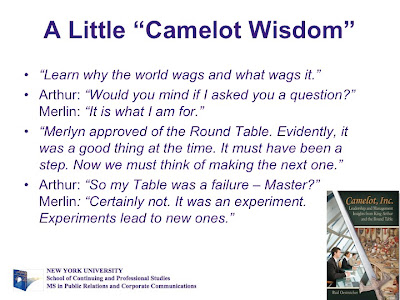This article first appeared in the MENG (Marketing Executives Networking Group) Blend.
How many
times have you heard it? “Tell me something I don’t know.” “Give me your best
creative ideas.” “I want a concept that people will be talking about.”
It
doesn’t matter if you’re inside an organization or sitting in an agency – there
is a never-ending desire and need for differentiation. Whether it’s a company,
product or person, engaging and persuading stakeholders often involves
thoughtful, clever marketing. The problem, though, is that creativity is both
misunderstood and dropping in supply.
Although
LinkedIn reported that “creative” was the most overused term in on-line
profiles1, a survey released in 2010 by IBM of more than 1,500 CEOs
from 60 countries and 33 industries emphasized that even “more than rigor, management
discipline, integrity, or even vision—successfully navigating an increasing
complex world will require creativity.” Creativity was cited by 60 percent of
the CEOs as the most important attribute; integrity was next at 52 percent.2
With such a high premium placed on creativity, the CEOs in the survey signaled
some concern because less than half of them “believe their enterprises are
adequately prepared to handle a highly volatile, increasingly complex business
environment.”
This may
not be just a staffing problem. It may also mean that there are not enough
creative thinkers to go around. Indeed, there is some evidence to suggest that
we may be heading for a creativity crisis. A review of nearly 300,000
creativity tests, also called Torrance scores, of children and adults collected
over several decades showed that American creativity has been declining since
1990.3 (These tests were based on the work of the late E. Paul
Torrance, an educational psychologist best known for his research on
creativity.)
Yet,
creativity is in the eye of the beholder. There’s more than one definition and
more than one way that creativity can lead to a successful outcome. Still, we
must ensure that our educational system emphasizes idea generation and
problem-solving techniques in addition to the more traditional memorization and
drills.
Recognizing
the importance of creativity, some advertising and public relations agencies
have elevated people into positions such as chief creative officer. You may
have also seen the titles creative guru, creative ninja, or even head of
creation (which may get an argument from, shall we say, a higher authority). That’s
all fine but I have known a few who took their titles to mean that creativity
was their personal domain and theirs alone. These individuals would go into
seclusion so they could develop “the big idea.” Then, they presented their
concepts as a fait accompli, like
Athena bursting out of Zeus’s head fully armored and ready for battle. We want
and need exceptional thinkers on our team, but they sometimes rail against
process and fail to realize that there is, or should be, a team. Without good
leadership from the “creative types,” the other human resources in the
organization will be wasted and demoralized.
While
meeting the business objective is the ultimate measure of success, it’s been
known that the quest to be creative sometimes becomes the objective in itself. In
the drive to knock the socks off of the client, or win an industry award, the
true customer – the end-user – is forgotten. We need to spend more time
orienting on the audience, reminding ourselves of the real prize. As King
Arthur said when he rose to power, “I
don’t think things ought to be done because you are able to do them. I think
they should be done because you ought to do them.”4
As a fan
of the Arthurian legends, I was taken aback by a comment made about his style
of thinking toward the end of his life: “The
old man had always been a dutiful thinker, never an inspired one.”5
What was meant by this? Was it an insult? Was there an implication that dutiful
thinking was inferior to creative thinking? The truth is we need both. A
dutiful thinker is a habitual thinker, one who is always observing, searching
for solutions, and attempting to anticipate the future. The creative spark is
precious but dutiful thinking, steady and stepwise, is a virtue of its own. Sometimes
we can get to the goal line in one play. More often, though, progress is made
in important, incremental steps that ultimately add up to the win. As Merlin,
Arthur’s mentor, told him: “…the only
thing worth doing for the race is to increase its stock of ideas.”6
The
creativity deficit could be reversed in short order if more people adopt the
concept of marrying dutiful with inspired thinking. Getting ourselves and
others to think a bit more and a bit more regularly is surely a lot easier than
other New Year’s resolutions we’ve proclaimed and then later abandoned. It’s
interesting to note, too, that habitual thinking is a form of mental exercise
that, over a lifetime of consistent contemplation, changes our neurological
patterns.7, 8 More time thinking helps to remodel our brains so that
we get better at thinking. If only weight loss and getting in better shape were
this painless!
2. 2010
IBM Global CEO Study, http://www.ibm.com/ceostudy.
3.
Attributed to Kyung-Hee Kim in P. Bronson and A. Merryman, “The Creativity
Crisis,” Newsweek, July 19, 2010.
4. White,
T.H., The Once and Future King, p.
246.
5. White,
T.H., The Once and Future King, p.
630.
6. White,
T.H., The Book of Merlyn, p. 11.
7. R. E.
Jung et al., “Biochemical Support for the ‘Threshold’ Theory of Creativity: A
Magnetic Resonance Spectroscopy Study,” Journal of Neuroscience 29:16 (2009):
5319–5325.
8. R. E.
Jung et al., “Neuroanatomy of Creativity, Human Brain Mapping,” Journal of
Neuroscience 31:3 (2010): 398–409.













